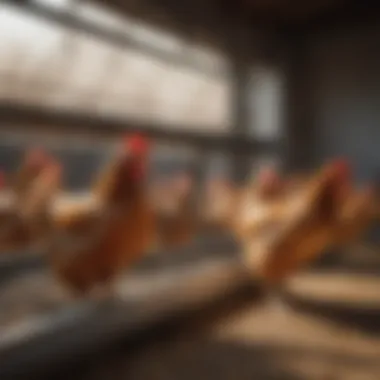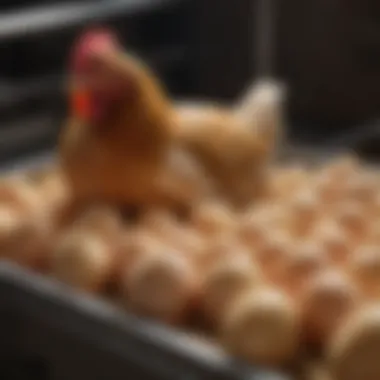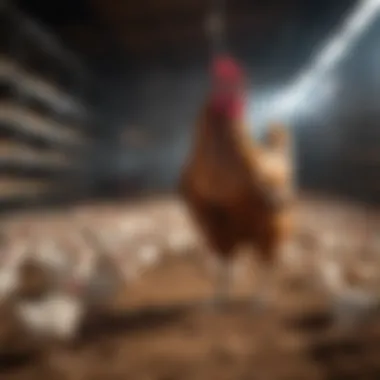Understanding Chicken Brooders for Poultry Management


Intro
Chicken brooders are vital in modern poultry management. They provide a controlled environment for young chicks, ensuring their health and growth. As poultry farming evolves, understanding the intricacies of brooders becomes crucial. This article delves into the essentials of chicken brooders, covering their purpose, design options, and the operational considerations that enhance poultry management. By grasping these concepts, both novice and experienced poultry keepers can optimize their rearing practices, promoting better outcomes in their flocks.
Current Trends in Agriculture and Horticulture
In recent years, the agricultural landscape has seen significant changes. The trend toward more sustainable and efficient farming methods is reshaping how poultry farming is approached. Knowledge of these trends is essential for effective poultry husbandry, particularly regarding chicken brooders.
Overview of Recent Innovations
Modern technology is enhancing traditional poultry farming practices. Innovations include the use of smart brooders, which incorporate temperature and humidity controls. These systems can be monitored remotely via apps, allowing farmers to maintain optimal conditions effortlessly.
Key innovations in chicken brooders include:
- Automatic Temperature Control: Maintaining exact temperatures is crucial. Automatic systems adjust heating elements based on real-time data, ensuring chicks are always comfortable.
- Humidity Regulation: Proper humidity levels promote better chick health. Modern brooders often include sensors to regulate humidity automatically.
- Enhanced Insulation: New materials provide better thermal insulation, decreasing energy costs while maintaining stable temperatures.
Sustainable Practices Gaining Popularity
Sustainability is a growing focus in agriculture. Many poultry keepers are now implementing practices that reduce their ecological footprint. Simple changes can have significant impacts.
- Using Renewable Energy: Solar panels for heating brooders contribute to reduced reliance on non-renewable energy sources.
- Recycling Water: Efficient water management systems help conserve resources.
- Natural Feed Options: A shift toward organic or locally sourced feed supports healthier chicks and reduces chemical exposure.
Adopting these practices allows poultry farmers to align with broader sustainability goals, appealing to an increasingly conscious consumer base.
Understanding Chicken Brooders
Brooders, in their essence, function as a surrogate mother for chicks. Their core role is to provide the necessary warmth and safety for chicks during their initial critical weeks.
Types of Brooders Available
There are several types of chicken brooders on the market:
- Infrared Brooders: These use radiant heat to warm the chicks, effectively mimicking natural sunlight.
- Gas Brooders: Utilizing propane, these are effective for larger operations needing consistent heating.
- Electric Brooders: Common in smaller setups, electric brooders are easy to use and maintain.
Selecting the right type depends on the scale of operation and specific needs of the chicks.
Essential Features for Optimal Chick Development
For chick development, several features are essential in brooder design:
- Adjustable Heat Levels: Newly hatched chicks require higher temperatures.
- Adequate Space: Crowding can lead to stress and health issues. Enough space is vital.
- Easy Access to Food and Water: Automation in providing food and water encourages healthy growth.
- Safety Features: Non-flammable materials and protective barriers are key to ensuring chick safety.
By understanding and implementing these features, poultry keepers can provide optimal conditions for their growing flocks.
"Creating the right environment for chicks leads to stronger, health birds and ultimately a better yield for poultry farms."
Common Challenges and Maintenance Requirements
Even the best brooders have challenges. Temperature fluctuations, power outages, and equipment malfunctions can arise. Regular checks and maintenance can mitigate most issues. This includes cleaning equipment regularly and monitoring temperature and humidity levels, as fluctuations can severely impact chick health.
Closure
Staying aware of the ongoing developments in the field will foster progressive practices and encourage a healthier, more sustainable approach to poultry management. For further information, visit Wikipedia or explore resources on Britannica.
Preamble to Chicken Brooders
Chicken brooders play a crucial role in poultry husbandry by providing a controlled environment for young chicks. Understanding the dynamics of brooders is essential for ensuring the health and welfare of chicks during their early development. In this section, we will explore the definition and purpose of chicken brooders along with a historical context to highlight their evolution over time.
Definition and Purpose
A chicken brooder is essentially a device that creates a warm, safe space for newly hatched chicks. These delicate birds require specific temperature ranges, protection from environmental extremes, and adequate ventilation to thrive. The primary purpose of a brooder is to simulate the warmth and security that a mother hen provides, which is vital for maintaining chick body temperature and overall health.


The importance of temperature cannot be overstated; chicks need heat to digest food properly and grow. Without a suitable brooding environment, survival rates may drop significantly. In addition, brooders must provide easy access to feed and water, promoting healthy growth. They also serve as a containment area to prevent chicks from straying too far, which can lead to stress or predation.
Historical Context and Evolution
Historically, poultry farming relied heavily on natural brooding by hens. Raising chicks under a brood hen was common practice, as the mother would instinctively regulate temperature and ensure protection. However, as the demand for poultry products rose, farmers sought more efficient and controlled methods for chick rearing.
The evolution of chicken brooders began in the early 20th century with innovations like heated enclosures. Automatic heating and ventilation mechanisms were gradually introduced, allowing farmers to manage larger flocks. Today, modern brooders come equipped with advanced technology, including thermostats and climate control systems. This progression has contributed to increased survival rates and improved efficiency across the poultry industry.
"The transition from natural to artificial brooding marks a significant stride in poultry management, reflecting advancements in agricultural practices."
Understanding the significance and evolution of chicken brooders establishes a foundation for exploring the various types of brooders available today. It also aids farmers in making informed decisions, ensuring successful poultry management.
Types of Chicken Brooders
The role of chicken brooders is pivotal in the realm of poultry husbandry. Selecting the right type of brooder can significantly affect the health, growth rate, and overall wellbeing of chicks. Factors like mobility, heat source, and design impact not only the care of the animals but also management practices for farmers. Understanding the various types of chicken brooders available ensures that poultry keepers can provide the best possible environment for their chicks.
Natural vs. Artificial Brooding
Natural brooding involves hens incubating their eggs and caring for their chicks. This traditional method capitalizes on the instinctual behaviors of chickens. Benefits include lower labor costs and a more natural grouping of chicks. However, it can be less predictable based on the hen's ability to provide adequate warmth and protection.
Artificial brooding utilizes equipment designed to mimic hen warmth. This method is preferred in commercial settings because it allows for precise control of the environment. Factors like temperature, humidity, and ventilation can be maintained consistently. Each method has its pros and cons, but the choice often depends on the scale of poultry operations and the desired level of control over environmental conditions.
Portable Brooders
Portable brooders provide flexibility in managing chicks. They can be moved to different locations based on factors like land use and weather conditions. These unit types often come equipped with wheels or handles for ease of transport. The main advantage is being able to relocate chicks to areas with better access to natural light and fresh air. However, they may not offer the same level of insulation found in more stationary setups. Farmers should consider seasonal weather changes when opting for portable brooders.
Fixed or Stationary Brooders
Fixed or stationary brooders are permanent structures designed specifically for brooding. They are typically larger and provide ample space for many chicks. This type allows for better control over temperature and airflow while also offering stability in physical layout. However, fixed brooders require more investment in terms of construction and maintenance compared to portable options. The decision between fixed and portable depends on the scale of the poultry farm and the long-term management plans of the farmer.
Infrared and Heat Lamp Brooders
Infrared and heat lamp brooders use specialized heat lamps to provide warmth for chicks. Infrared lamps, being energy-efficient, offer consistent heating without the need for direct contact with the heating element. This advantage allows for multi-brooder setups and savings on energy costs. However, improper placement can lead to overheating or insufficient warmth, which can harm the chicks. Proper installation and monitoring are crucial to ensure the effectiveness of these systems.
Electric Brooders vs. Gas Brooders
When it comes to heating, chicken brooders can be powered by electricity or gas.
- Electric brooders provide reliable, controllable heat and are easy to monitor.
- Gas brooders, on the other hand, may be more cost-effective in areas with high electricity costs. They can also offer heat even during power outages.
Both options come with their own set of challenges. Electric brooders require adequate power sources while gas brooders need proper ventilation to avoid any toxic buildup.
Choosing the right heating system often depends on geographical location, accessibility of resources, and specific needs of the brooders.
Essential Features of Chicken Brooders
The effectiveness of chicken brooders primarily hinges on their essential features. These elements are crucial for supporting the growth and development of chicks during their vulnerable early stages. First and foremost, temperature control is essential because chicks rely on external warmth to thrive. A consistent and appropriate temperature can prevent heat stress or chilling, which can be detrimental to their health.
Another key element is ventilation requirements. Proper air circulation is vital to provide fresh air and prevent the buildup of harmful gases like ammonia. Inadequate ventilation can lead to respiratory issues and stress among the chicks, impacting their overall well-being and growth.
Space considerations play a significant role, too. Chicks need enough room to move about, socialize, and establish a hierarchy. Overcrowding can lead to injuries and anxiety, which affects their development. It's essential to design brooders that offer spacious environments for chicks to thrive.
Feeding and watering systems are also indispensable features. Easy access to nutritious feed and clean water is crucial for the healthy growth of chicks. The design of these systems should minimize waste while ensuring that every chick can reach food and water without competition or stress.
Lastly, attention to bedding and cleaning protocols is necessary for maintaining hygiene in the brooder. Clean bedding reduces the risk of diseases, and effective cleaning protocols are essential to managing the environment where chicks grow. Regular assessments of these features can significantly enhance chick health and productivity.
"A well-designed brooder is not just a space for chicks; it is a foundational element that affects their transition into adulthood."
In sum, the essential features of chicken brooders encompass temperature control, ventilation, space considerations, feeding and watering systems, along with bedding and cleaning protocols. Each of these components plays a pivotal role in achieving effective poultry husbandry.
Setting Up a Chicken Brooder
Setting up a chicken brooder is a critical step in ensuring the health and wellbeing of young chicks. A well-designed brooding environment can significantly affect the growth rate and overall vitality of the flock. Properly configuring this space enables farmers to maintain convenient access to the chicks while regulating their comfort and safety. It requires carefully considering numerous factors, including location, setup guidelines, and monitoring changes in conditions. A successful setup fosters a nurturing atmosphere where chicks can thrive, transitioning smoothly as they grow.


Choosing the Right Location
The choice of location for the chicken brooder can have a notable impact on the chicks. It should be situated in a sheltered area to protect against harsh weather conditions. A location that is too drafty can lead to hypothermia in young chicks, while excessive heat can cause stress. Additionally, the brooder needs to be easily accessible for feeding, watering, and cleaning. Ideally, choose a place that is away from existing poultry flocks to minimize the risk of disease transmission. You can also consider placing it in a location where the farmer has easy access to electricity, especially if using electric heating sources.
Optimal Setup Guidelines
Establishing an effective brooder setup goes beyond basic arrangements. Here are several aspects to consider:
- Space: Allocate sufficient square footage per chick to avoid overcrowding. A general guideline is 0.5 to 1 square foot per chick in the initial stages.
- Temperature Regulation: Utilize heat lamps or electric brooders to maintain an optimal temperature of 90-95°F in the first week. Gradually lower the temperature by 5°F each week.
- Bedding: Use clean, dry bedding such as straw or wood shavings to provide comfort and absorb moisture. Change bedding regularly to minimize bacterial growth.
- Feeding and Water Stations: Position feeders and waterers at the appropriate height to ensure easy access by chicks. Bootstrap these for easy clean-up and arrange them to avoid waste and contamination.
Proper setup is crucial for achieving a productive and prosperous poultry operation.
Monitoring Initial Conditions
After setting up the brooder, continuous monitoring of the initial conditions is essential. Farmers should check temperature and humidity levels daily to ensure they remain within the comfort zone for chicks. A thermostat or thermometer can help maintain the desired temperature, while a hygrometer will inform about humidity levels.
- Behavioral Observations: Pay attention to the chicks' behavior. If they huddle under heat sources, they may feel cold; if they are scattered away from the heat, it might be too hot.
- Record Keeping: Keeping a log of temperature, humidity, and behavioral changes can help in understanding trends and making necessary adjustments. This practice aids in proactive management and timely intervention if necessary.
Establishing a suitable environment during brooding is not just about immediate comfort; it sets the stage for future health and productivity in the flock.
Best Practices for Chick Care
Caring for chicks in a brooding environment is paramount for ensuring their healthy development. Implementing best practices in chick care can create a stable environment that caters to their specific needs. The right approach includes daily routines, attention to their behavior, and ensuring they receive adequate social interaction. Understanding these elements contributes to not only their short-term well-being but also their long-term productivity as adult birds.
Daily Monitoring and Maintenance
Daily monitoring of chicks is essential for maintaining optimal conditions within the brooder. Routine checks on temperature, humidity, and cleanliness can prevent potential health issues. It is crucial to check the temperature frequently, as chicks are sensitive to both cold and heat. Ideal temperatures usually range from 90°F to 95°F for newly hatched chicks, gradually decreasing as they grow older.
Regularly inspecting the bedding for moisture and waste is also important. Clean bedding minimizes the risk of disease outbreaks. Remove any soiled bedding promptly and replace it with fresh material. Additionally, ensure that feeding and watering systems are functioning well to prevent any shortages.
Recognizing Signs of Distress
Chicks cannot verbally communicate their discomfort, making it vital to understand the signs of distress. Common indicators include unusual vocalizations, lethargy, or huddling together. If chicks appear to be panting or spreading their wings, they may be overheated. Conversely, if they are piling up in corners, they might be too cold. Regular observation will help you distinguish normal behavior from signs of discomfort.
It is also beneficial to familiarize yourself with the visual signs of disease, such as unusual droppings or feather pecking. Early detection can make a significant difference and ensure that chicks receive timely intervention when needed.
Socialization and Interaction
Social interaction is a critical aspect of raising healthy chicks. Providing a stimulating environment promotes natural behaviors and reduces stress. Chicks are social birds and benefit from interactions with their peers as well as with humans.
Handling chicks gently can promote trust. Spend time observing and interacting with them, helping them acclimate to human presence. Consider introducing toys or materials that encourage exploration without posing a risk, such as small mirrors or shiny objects. This helps develop their confidence and curiosity, ensuring they grow into well-adjusted hens or roosters.
"Consistent interaction fosters a bond between the caretaker and the chicks, which can enhance their overall development."
Common Challenges in Brooding
Growing chicks require careful attention, especially during the brooding stage. Various challenges can arise that impact the health and well-being of the flock. It is crucial for poultry keepers to understand these common challenges. Addressing them promptly fosters a thriving environment for growing birds. Each challenge has its specific aspects and demands focused strategies to ensure the best outcomes.
Heat Stress and Overheating
Heat stress is one of the most common challenges faced by poultry keepers during the brooding stage. Birds are particularly vulnerable to temperature fluctuations, and maintaining the correct temperature is essential. Ideal temperature ranges can help ensure the chicks are comfortable and growing properly.
A sudden rise in temperature can lead to overheating, causing distress and even mortality in extreme cases. To prevent this, monitor the brooder temperature closely. Using thermometers or technology-enabled monitoring devices can provide real-time data. Proper ventilation is also vital for preventing heat buildup.
To help manage these conditions, consider the following strategies:
- Regularly check the temperature and air circulation.
- Use fans to enhance ventilation in hotter periods.
- Adjust heating sources when signs of discomfort are noticeable.
"A balanced environment is key to reducing stress and ensuring healthy brooding."
Flock Management and Mortality Issues


Managing a flock during the brooding stage brings multiple challenges. Mortality rates can increase due to several factors, including stress, improper nutrition, and environmental conditions. It is essential to track each chick's development and respond to any issues. Monitoring growth can help address any problems early on.
Implementing better flock management practices can lead to improved survival rates. Keeping the brooder clean and ensuring adequate space for each bird also contributes to overall health. Additionally, ensuring that each chick receives adequate nutrition can affect their immunity and growth.
Key points for effective flock management:
- Maintain a close watch on the behavior of the birds.
- Provide sufficient space to reduce competition and stress.
- Ensure a consistent feeding schedule to promote good health.
Disease Prevention Strategies
Preventing disease in young chicks is crucial during the brooding period. Crowded conditions, poor hygiene, and inadequate temperature can contribute to illness outbreaks. New poultry keepers often overlook the importance of biosecurity measures. Practicing good biosecurity helps minimize the risk of diseases.
Some effective disease prevention strategies include:
- Regular Cleaning: Ensure that the brooder area is clean to prevent pathogen buildup.
- Quarantine New Arrivals: Isolate new chicks for a period to monitor for signs of illness.
- Vaccination Protocols: Follow vaccination schedules recommended by veterinarians.
By being proactive about disease prevention, poultry keepers can create a healthier environment for their flock. Being aware of these common challenges can significantly enhance the success of poultry husbandry.
Transitioning from Brooder to Rearing
Transitioning from the brooder to the rearing environment is a critical phase in poultry husbandry. This step affects the health, growth, and future productivity of the birds. Proper management during this transition promotes overall well-being and eases the changeover. Needing to pay careful attention to multiple factors can help maximize the chances of success when moving chicks into a more permanent setup.
Signs of Readiness for Transition
It is essential to observe the chicks closely for signs of readiness before transitioning them from the brooder. Key indications include:
- Ability to Regulate Temperature: When chicks can maintain their body temperature efficiently, it indicates they no longer rely on the heat source of the brooder.
- Feather Development: The presence of adequate feathers helps birds adapt to cooler temperatures in outdoor environments.
- Activity Levels: Increased activity and curiosity show readiness for new surroundings.
- Social Interaction: When chicks start to exhibit normal social behaviors, including pecking, foraging, or establishing a pecking order, they are often ready to change environments.
These signs collectively suggest that the chicks are developing the necessary skills and physical attributes needed for life beyond the brooder.
Gradual Prologue to Outdoor Environments
A sudden shift to outdoor conditions can be overwhelming and stressful for young chicks. Therefore, a gradual introduction is beneficial. This process involves:
- Short Outdoor Sessions: Start with brief periods outside, allowing them to explore their new environment while keeping a close watch.
- Safety Measures: Ensure the area is safe from potential predators. Use fencing or enclosures that protect the chicks while they acclimatize.
- Weather Considerations: Monitor the weather conditions. Avoid introducing chicks to harsh or extreme climates too soon.
- Access to Shelter: Provide easily accessible shelter to give them a sense of security.
This phased approach eases the transition, helping chicks adapt more comfortably to their new home.
Establishing a Rearing Space
Creating a suitable rearing space is crucial once you’ve determined the chicks are ready to transition. Factors to consider include:
- Size and Space: Ensure the area is large enough to accommodate the growing flock, allowing free movement and minimizing stress.
- Environment Control: Plan for proper ventilation, lighting, and climate control to promote health and well-being. This helps prevent respiratory issues or heat stress.
- Feeding and Watering Stations: Design the space with adequate feeding and watering spots, ensuring all birds have access.
- Bedding and Cleanliness: Choose an appropriate bedding material and establish a cleaning routine to maintain hygiene.
- Safety Protocols: Prevent access to hazardous materials or equipment within the space, ensuring it is safe for the chicks.
Setting up an effective rearing area promotes a smooth transition and helps reduce stress among the chicks.
Culmination
In this article, we explored the critical elements of chicken brooders and their role in effective poultry husbandry. A brooder acts as a safe and nurturing space for newly hatched chicks, essential for their initial growth and development. Understanding the various types of brooders, their features, and the best practices for maintaining the environment is paramount for any poultry keeper.
The conclusion synthesizes the knowledge gathered throughout the article, emphasizing the importance of a well-maintained brooding environment. Proper temperature control, adequate space, and ventilation are more than just requirements; they are the bedrock for healthy chick development. By being attentive to these factors, poultry keepers can significantly enhance the survival rate and well-being of their flocks.
Benefits of a careful approach to brooding include:
- Increased Survival Rates: A controlled environment minimizes stress and mortality.
- Enhanced Growth: Proper care allows chicks to reach market weight faster.
- Disease Prevention: Clean and well-managed brooders reduce infection risks.
Considering these aspects ensures that farmers can provide the best start for their chickens, ultimately leading to productive poultry operations.
Summary of Key Takeaways
As we conclude our discussion on chicken brooders, several key points stand out.
- Purpose of Brooders: They create a warm, secure area for chick development away from threats.
- Types of Brooders: Various options are available depending on scale, including natural, portable, and electric models.
- Essential Features: Temperature, ventilation, space, and sanitation are critical to the health of chicks.
- Best Practices: Regular monitoring of conditions and handling of chicks supports their comfort and growth.
- Challenges: Awareness of issues such as heat stress and flock management helps in developing effective strategies.
Future Considerations for Poultry Management
Looking toward the future, poultry management will continue to evolve alongside advancements in technology and research. Here are some key considerations:
- Innovative Brooding Technologies: Advancements in automation and temperature regulation will change how brooders are designed and operated.
- Sustainability Practices: There is a growing emphasis on sustainable poultry farming. This trend might encourage the development of eco-friendly brooding systems.
- Health Monitoring Tools: Technology such as smart sensors can aid in real-time monitoring, ensuring a quicker response to environmental changes.
- Educational Resources: Continued education on poultry management will be vital, helping farmers adapt to new practices and improve efficiency.



